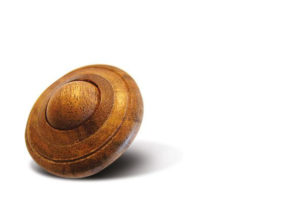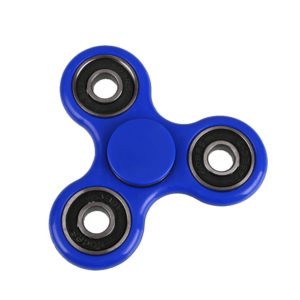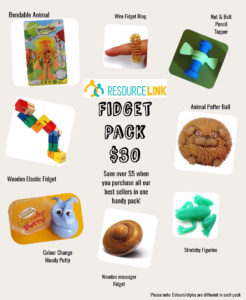Classroom tips series- Fidgets… How to get the best out of them!
With the recent interest around the popular fidget spinners, we thought this would be a good time to add our two cents and provide a short post about fidgets with some tips around how fidgets can be used to support sensory regulation in the classroom.
- All children have different sensory preferences and therefore require different kinds of input in order to regulate their body and attention levels. This can be through movement, oral, olfactory (smell), auditory, visual, tactile or proprioceptive input. Fidgets provide a small amount of movement or tactile type of input, which can help kids when they need to sit still and focus. While they can be very useful, they are certainly not a fix all approach.
- Persisting and being consistent with fidgets is important. Like any new thing, often the novelty needs to wear off before a child will be able to sensibly make use of a great fidget. At first it is almost expected that their attention will be drawn to the new thing they have in their hand.

- Fidget rules are essential. We teach kids the following 3 rules; 1. It stays in your lap, 2. It’s for hands not eyes, 3. It doesn’t distract other children. If these rules are broken, the fidget is removed for a period of time and then returned to the child to “try again”. We encourage teachers and parents to per sist for a couple of days before trying a different fidget or sensory strategy.
- The best kinds of fidgets are small, non-toy based, quiet and moveable/tactile. This allows for the child to keep it in their pocket as well as limiting distractions or using the fidget when it’s not required. Fidgets are not supposed to necessarily be “fun”, they are to keep fingers busy. E.g. The child’s favourite Transformer is probably not going to be the best choice of fidget.
 Fidget spinners can be a great sensory tool however it can be difficult to follow the fidget “rules” due to their size and visual nature. However, they ca be beneficial as a calming visual tool or when the child’s visual attention is not required for other tasks. They definitely have a place, it just may not be floor time.
Fidget spinners can be a great sensory tool however it can be difficult to follow the fidget “rules” due to their size and visual nature. However, they ca be beneficial as a calming visual tool or when the child’s visual attention is not required for other tasks. They definitely have a place, it just may not be floor time.
- Fidgets are more of a supplemental tool and don’t usually provide a child with all of the sensory input they need. They may assist to help a child to pay attention for certain tasks, however don’t necessarily replace other sensory strategies such as regular movement breaks, heavy work (lifting, pulling, pushing or body weight exercises) or deep pressure (such as a weighted lap blanket). A fidget does not usually offer sustained benefits (like heavy work does) and is more an “in the moment” tool.
- We feel it’s important for children to understand the “why” of sensory tools and have a deeper understanding of self-regulation, in order to truly benefit from a fidget and to make sure it is used effectively. This is often where OTs come in.

We hope this provides some useful information about fidgets and some tips when using them in the classroom. Please give us a call if you have any questions about sensory processing or how to support concentration in class.
We have packaged 8 of our favourite fidgets together in a handy pack. Click here if you would like to purchase one.
Bloggers: Caitlin Smith and Jackie Sikic
Occupational Therapists at Kid Link OT



